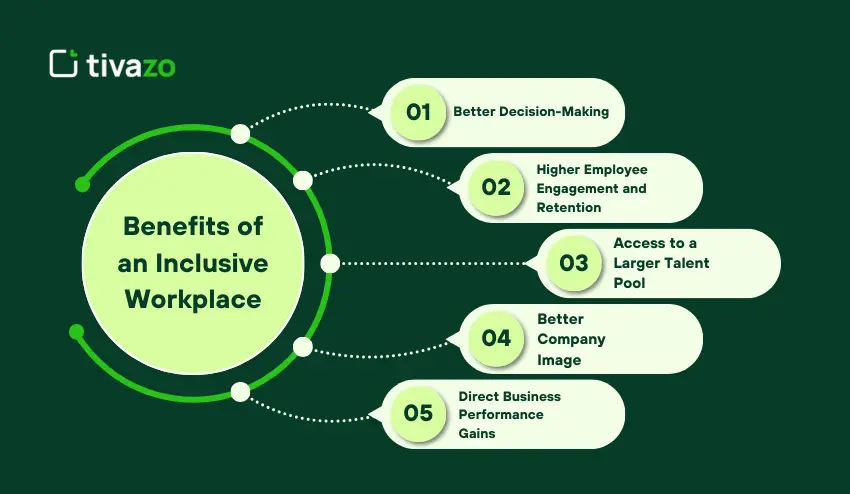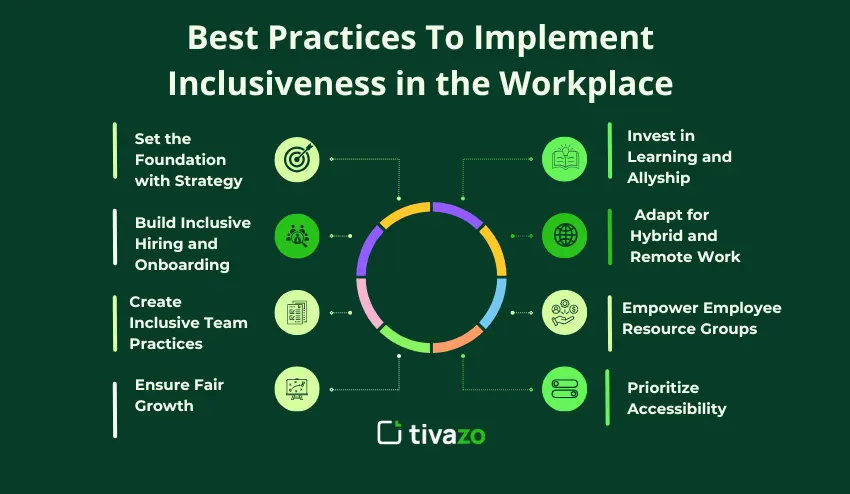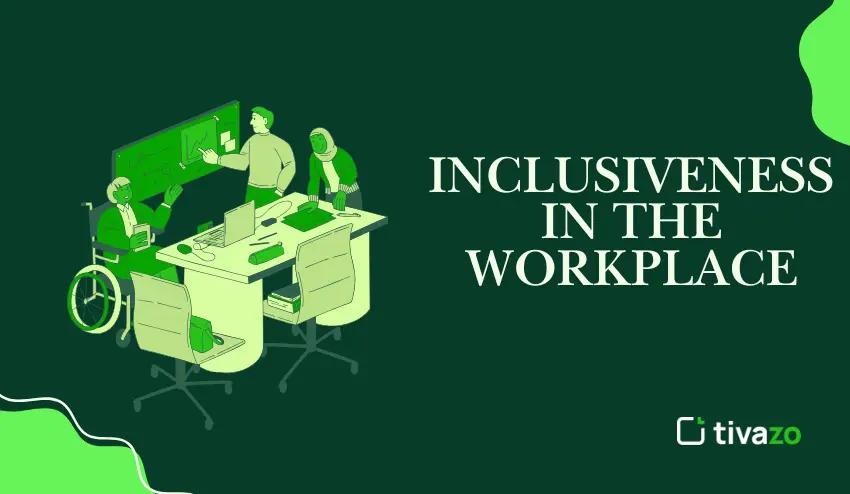Think back to the best team you’ve ever worked with. I bet it wasn’t purely smart people doing their jobs. It was a team in which every person felt heard, respected, and valued. That feeling of belonging is what being inclusive in the workplace is all about.
With the rise of hybrid work, global teams, and competition for top talent at an all-time high, organizations can’t afford to ignore inclusion anymore. Employees do not merely want a paycheck. They want to be part of a workplace that embraces who they are as individuals and gives them a fair opportunity to succeed.
This blog post aims to help you understand the pressing need for inclusion in the workplace, challenges often faced by organizations, and best practices that work. Based on my experience of working with leaders, HR teams, and employees to improve inclusion strategies, I’ll share tested steps and lessons learned. By the end of this post, you will have the knowledge of what to do and how to implement inclusion as part of your regular business practices.
Let’s start at the beginning. First, let’s get some clarity on what inclusiveness in the workplace means and how it is distinct from the words diversity and equity.
What is Inclusiveness in the Workplace (and How It Differs from Diversity & Equity)
Inclusiveness in the workplace is not simply about hiring individuals with diverse backgrounds. It is about building a place where everybody feels like a part of it and can do something without limitations. Simply put, diversity is the people in the room, whereas inclusiveness is the manner in which these people are treated after being in the room.
Put it in another way: you may have a team that appears to be diverse on paper, but will not work when some voices are overlooked or disregarded. Inclusiveness at workplace guarantees that all employees, irrespective of their gender, age, ethnicity, abilities, or beliefs have equal opportunities, resources and respect.
The distinction between inclusion, equity, and belonging also deserves to be mentioned. Equity is concerned with fairness within systems, such as pay systems and promotions. Belonging is the individual sense of acceptance. The key to the two lies in their intermediate inclusiveness, which is the day-to-day activities that enable equity to become a reality and belonging to become an option.
Inclusiveness in the workplace is not merely a policy when organizations do it right. It is integrated into the culture, and it influences decision-making, leadership approach, and the manner in which employees relate to each other.
With the definition out of the way, we can move on to consider why establishing an inclusive workplace has become a burning business concern.
The Business Case: Benefits of an Inclusive Workplace
Most leaders still believe that inclusiveness in the workplace is simply doing what is right. And, in fact, it is also an established business performance driver. Firms with an inclusion focus tend to achieve better outcomes in productivity, engagement, and innovation.

- Better Decision-Making and Innovation
Diversity of views at the table enhances the quality of the decisions made by teams. Diverse teams debate the ideas of each other and identify blind spots more quickly. This usually results in more innovative problem-solving and new ideas, which represent the needs of various customers. That is, workplace inclusiveness is the direct driver of innovation. - Higher Employee Engagement and Retention
When employees feel satisfied and valued, there are high chances that they will remain in organizations. When one feels ignored all the time, he or she begins to tune out or seek other attention. Conversely, an inclusive environment makes employees motivated and connected. Research indicates that organizations that are inclusive in the workplace experience less turnover and increased employee loyalty. - Access to a Larger Talent Pool
Modern workforce prefers to work in organizations that portray fairness and opportunity. Companies that emphasize inclusiveness at work have more applicants, particularly the younger generations who are keen on seeking inclusive cultures when seeking employment. Through inclusion, you not only broaden your talent base, but you also create a brand that is an employer of choice. - Better Company Image and Customer Confidence.
The customers will observe the treatment of the employees by the companies. An image of being inclusive at the workplace can enhance brand image and customer loyalty. Citizens desire to patronize organizations that portray principles of justice and decency. - Direct Business Performance Gains
Studies have always indicated that inclusive organizations perform better than others. The higher the performance of a team, the greater the revenue and market share, which are achieved through inclusive leadership and cultures. Incusiveness in the workplace is not only a matter of social responsibility, but it also directly affects business results.
At this point, it becomes obvious that inclusiveness in the workplace is not only a nice-to-have. It’s a business necessity. But it is not always easy to achieve that degree of inclusiveness in the workplace. We can examine some of the pitfalls that most companies encounter in the process of creating inclusive environments.
The Real Challenges (and Root Causes)
The idea of establishing inclusiveness at the workplace is easy to hear, yet numerous organizations cannot translate the intentions into practice. We can divide the most frequent obstacles and their reasons.
1. Performative Actions Without Real Change
There are those organizations that take inclusion as a check box. They conduct a diversity awareness program once or share their diversity awareness on social media, but never follow it up with long-term modifications. This is a performative style that causes employees to lose confidence. The concept of inclusiveness at the workplace should not only be superficial.
2. Leadership Gaps
Inclusion starts at the top. Unless the leaders are totally dedicated or they know how to lead by example, employees will pick up. Most leaders are not trained on how to deal with diverse teams, provide fair feedback, and deal with unconscious bias. Incusiveness at the workplace can hardly be achieved without the buy-in of leadership.
3. Resistance or Pushback
Change is not a comfortable experience, and not all people welcome it. Other employees might oppose the inclusion efforts as they may view them as a waste of time or as a form of injustice. Other people might be exhausted with new projects, particularly when previous attempts have not worked. This opposition is able to create friction and slow the pace.
4. Lack of Clear Policies and Systems
Inclusion cannot be based on personal goodwill. There should be clear policies on hiring, promotions, pay equity, and accommodations, and biases creep into the decision-making. The workplace should be inclusive, and this should be done through organized systems so that fairness is the norm rather than the exception.
5. Everyday Barriers and Microaggressions
Although formal policies are in place, employees can be subject to unspoken obstacles. Interruptions in meetings, jokes at someone’s expense, or assumptions about ability all undermine inclusion. Such minor yet repeated actions accumulate and form a culture in which not all people feel safe to participate.
6. Hybrid and Remote Inequities
With the introduction of hybrid work as a new standard, different issues emerge. Remote workers tend to feel left out of conversations, promotions, or networking. Digital accessibility, proximity biasness, time-zone fairness, and equality of visibility of remote employees must now be considered in inclusiveness in the workplace.
These are not easy to overcome, but with the proper mindset and tools, they can be done. And this is why the following part is devoted to the principles that any organization must follow to create a really inclusive culture.
Values of Creating an Inclusive Culture (Your North Stars)
It is also necessary to define principles that will determine inclusiveness in the workplace before plunging into tactics. They serve as the north stars of leaders and teams and make sure that all efforts are in line with the greater purpose.q

1. Psychological Safety
Employees must be comfortable enough to voice themselves, present ideas, and concerns without being judged. The workplace inclusiveness begins with the establishment of an environment where all voices are heard. Psychological safety enhances teamwork and enables teams to make superior decisions.
2. Fair and Transparent Systems
Processes and policies have to be made in a fair manner. Recruitment, salary, promotion, and performance appraisal must be founded on transparent and clean criteria. Inclusiveness in the working environment cannot succeed when individuals believe that decisions are made secretly or in favoritism.
3. Accessibility First
Inclusion is not just cultural but also about access. Inclusiveness in the workplace, whether it is in digital tools or in the workspace, entails making certain that employees with various needs can access them. This entails physical access, and such communication tools as captions, transcripts, and flexible formats.
4. Accountability for Leaders
Inclusiveness will not work when it is considered as an HR thing. At all levels, leaders should be responsible in the creation of inclusive teams. These involve modelling inclusive behaviors, solving problems promptly, and evaluating results. Inclusiveness in the workplace is not a project when the leaders assume ownership of the company.
5. Continuous Learning and Improvement
Inclusiveness is a process that is continuous. Teams are encouraged to constantly review what is working, what is not, and what is possible to improve. The practice of inclusiveness at the workplace becomes more effective when the organizations view it as a process rather than an end in itself.
These values are the guiding principles. Then we will put them to practice by examining the best practices that you can adopt to create and maintain inclusiveness in the workplace.
Best Practices To Implement Inclusiveness in the Workplace
Real change is found in putting principles into practice. Here are the best practices I’ve seen work in organizations that are serious about building inclusiveness in the workplace.

1. Set the Foundation with Strategy
Begin with the development of an effective inclusion policy. This policy should outline your commitment, define inclusiveness in the workplace, and explain how it connects to your business goals. Have an executive sponsor and a steering group to hold things to account.
The reason why most companies fail is that they consider inclusion as a temporary project. Rather, consider it as any other business strategy, with objectives, measures and periodical reviews. When inclusiveness in the workplace is written into policies and tracked like performance or revenue, it’s more likely to last.
2. Build Inclusive Hiring and Onboarding
Bias usually creeps in during hiring. Structured interviews and evaluation rubrics can be used to make hiring less subjective. Job requirements must be written in an inclusive language and should not include words that discourage underrepresented candidates to apply.
Once someone is hired, onboarding should reinforce inclusiveness in the workplace. This may involve assigning a buddy, the introduction of employee resource groups and arranging regular check-ins. A warm welcome with new hires makes them feel that they are welcome and this is a good omen of what to expect.
3. Create Inclusive Team Practices
Inclusion occurs in the day to day team meetings, projects and discussions. Establish meeting expectations like no interruptions, changing facilitators, and pre-sharing agendas. Encourage managers to actively invite quieter voices into discussions.
Communication is a big factor here. Inclusiveness in the workplace means using plain, respectful language, giving out constructive feedback, providing captions in virtual meetings, and making documents accessible. Even the minor things, such as recognizing cultural holidays or alternating the meeting time across time zones, are indicative of respect.
4. Ensure Fair Growth, Pay, and Promotions
Workers will soon lose confidence when they observe inequality during promotions or compensation. Carry out periodic pay equity audits to find loopholes and seal them. Promotions must be made on clear terms and managers must be trained on how to assess performance.
One of the best ways to support inclusiveness in the workplace is by setting up sponsorship programs. In comparison to mentoring, sponsorship makes sure that leaders work to promote high-potential employees who could be missed.
5. Invest in Learning and Allyship
Training works well when it is practical and role-specific. Rather than generic diversity workshops, work on competencies that employees can apply in their daily lives: how to provide feedback across differences, how to manage bias during an interview, or how to resolve a conflict inclusively.
Allyship is also critical. The employees are supposed to understand how to intervene in case of bias like speaking up when someone is interrupted. These behaviors help reinforce inclusiveness in the workplace and make inclusion everyone’s responsibility, not just HR’s.
6. Adapt for Hybrid and Remote Work
Remote work has revealed new barriers to inclusive environment. Ensure that remote workers receive equal promotions, recognition and leadership opportunities. Switch meeting schedules to fit global teams, and use asynchronous tools to ensure that everyone is not left behind.
Inclusiveness in the workplace now requires digital accessibility too. Use documents that are screen-reader friendly, alt text on images, and platforms that allow closed captions. Hybrid inclusion is no longer an option; it is an element of the creation of a modern workplace.
7. Empower Employee Resource Groups (ERGs)
ERGs give the employees a chance to exchange experiences, bond and give suggestions. To make them work, provide them with a clear charter, executive sponsors and a budget. Inclusiveness in the workplace grows stronger when ERGs are supported as part of company strategy rather than side activities.
8. Prioritize Accessibility in Tools and Spaces
Accessibility is not to be an after-thought. Physical access to offices should be available, including ramps, elevators, and universal washrooms. Online accessibility is also a significant aspect: adhere to the WCAG guidelines, provide easy navigation, and be mobile-friendly.
With built-in accessibility, you are helping not only the disabled employees but also making it easier to use. Inclusiveness in the workplace shines when barriers are removed at every level.
These best practices provide organizations with a roadmap that it can use step by step. Still, to prevent failures, one should also know what not to do.
Real-World Examples of Inclusiveness in the Workplace
Theory is important, but seeing how top companies put inclusiveness in the workplace into practice makes it easier to model success. The following are some of the good ones:
1. Microsoft – Accessibility as a Core Value
Microsoft has made inclusiveness in the workplace a cornerstone of its culture. They are innovative in adaptive technologies and they are accessible so that everyone with all abilities can maximize themselves. Their Autism Hiring Program is specifically aimed at hiring neurodifferent people, and it shows how the process of inclusiveness should begin with recruitment.
2. Accenture – Diverse Leadership Commitments
Accenture is known for embedding inclusiveness in the workplace at every level. They are audacious in their goals of having a gender balanced workforce by 2025, and they publicly state their accomplishment. The leadership is responsible, and inclusiveness is not just a point of talk but a delivery.
3. Salesforce – Employee Resource Groups (ERGs)
Salesforce has powerful ERGs, which help women, LGBTQ+ workers, veterans and so on. These groups have direct communication channels with leadership, ensuring inclusiveness in the workplace shapes decisions, not just social activities. They are also able to establish trust with the employees through their open reports on compensation.
4. Unilever – Inclusive Global Culture
Being in 190-plus countries, Unilever recognizes that cultural inclusivity is a must-have. They establish flexible ways of working and provide leadership training as part of their commitment to global inclusiveness as it relates to culturally diverse locations and markets. This commitment has made Unilever one of the most accommodating employers globally. Their diversity hiring strategy is the best among top leaders in the world.
5. Starbucks – Supporting Marginalized Communities
Through its investments in hiring refugees, veterans, and underemployed communities, Starbucks emphasizes inclusiveness in the workplace by providing tuition programs, mental health services, and training for diversity, equity, and inclusion – distinctly beyond the workplace and into the community engagement aspect of their corporate commitment.
Conclusion
Inclusiveness in the workplace is more than a policy, it’s a mindset that shapes how employees interact, contribute, and grow. Companies that are inclusive have more teamwork, better participation and business performance. Companies that integrate fairness, accessibility, and psychological safety into their daily operations will ensure that everyone in the firm feels valued and empowered.
Leadership needs to work and be responsible continuously in order to establish inclusiveness. Adhering to the principles and best practices listed here, tracking the progress, and telling it like it is will help to include it into the company culture. When done consistently, inclusiveness in the workplace drives innovation, retention, and long-term success for both employees and the business.




